LECTURE GIVEN AT THE: INTERNATIONAL MILITARY HISTORY FESTIVAL "BORODINO DAY" BORODINO, RUSSIA, SEPTEMBER 5-10, 1997 and at the SANDHURST MILITARY ACADEMY, LONDON, ENGLAND, FEBRUARY 18, 1998
Napoleon's Last Hours painting (slow: 127K)
Introduction: Napoleon's Accomplishments
Over 10 years ago, I wrote a book which explains the years of research that Sten Forshufvud, my colleague and friend from Sweden, and I did in order to prove without any doubt whatsoever that Napoleon was poisoned during his exile on St. Helena. The book, entitled "The Murder of Napoleon," was published in 28 languages and has sold over a million copies.
You know, people often ask me how I can be so sure that Napoleon was poisoned. After all, he has been dead for 176 years. The answer is relatively easy. Eight eyewitnesses told me so (through their books) and the information they supplied was confirmed through nuclear science. These eyewitnesses were in contact with Napoleon on a regular basis and reported what they saw in their diaries which they published once they returned home after Napoleon's death.
My research is based on eyewitness accounts of Napoleon's illness, confirmed through nuclear science. However I realized right from the start that we would have a difficult time in discrediting some of the well established historians who approved and repeated the misleading cause of Napoleon's death, as cancer of the stomach. Even though there was absolutely no proof to back up their statements.
To discredit these historians, we had to analyse all of the available evidence. I was encouraged by some of the world's most famous Napoleonic historians, such as David Chandler of England, Don Horward of the USA and Colonel Emile Gueguen of France.
They gave me their unfailing encouragement and a great deal of support. In the course of many years of research, I learned many things, in particular that stubbornness in the face of the truth and deafness and blindness in the face of facts are a reality even amongst some of the more intelligent historians.
FACTS, AS REPORTED BY EIGHT EYEWITNESSES, WERE IGNORED, OR THEIR MEANING HAS NOT BEEN UNDERSTOOD BY HISTORIANS.
The key that led us to the poisoning was Louis Marchand, Napoleon's first valet. He was attentive, discreet, literate, shrewd, observant and loyal beyond the call of duty. All historians agree with this evaluation of him. He was also a very good artist.
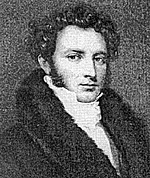 At right: Louis Marchand. First valet to Napoleon. His careful St. Helena diary notes, 140 years after he wrote them, helped reveal a secret assassination.
At right: Louis Marchand. First valet to Napoleon. His careful St. Helena diary notes, 140 years after he wrote them, helped reveal a secret assassination.
Napoleon treated Marchand like a son, and left him 400,000 francs in his famous will. Napoleon's desire was to honour Marchand with the title of "Count," and his wish was finally carried out when Napoleon III came to power.
Unlike the other companions in exile who wrote books in order to make a profit, Marchand kept a diary while in exile because he wanted his family to know what happened on St. Helena. He instructed his family never to publish these memoirs.
However, when his estate finally came up for sale, in the early 1950s, it was purchased by Commander Henri Lachouque of the French army, and he arranged to have Marchand's diary published for the first time in 1955.
HIS BOOK WILL GO DOWN IN HISTORY AS A "TIME BOMB" WHICH HELPED UNRAVEL THE MYSTERY OF NAPOLEON'S DEATH.
For your information, whenever I refer to Longwood House, you should be aware that it was Napoleon's prison home on St. Helena where he lived out his exile, and where he was poisoned.
Marchand's painstaking accuracy in recording the daily events at Longwood House, just as they occurred, made the equivalent of a doctor's case file of careful notes detailing the progressive decline of a terminally ill patient. HIS INFORMATION WAS VITAL IN "BLOWING THE COVER" ON WHAT WOULD OTHERWISE HAVE BEEN "THE PERFECT CRIME."
Marchand took home to France some of the actual hair that was shaved from Napoleon's head on May 6, 1821, and he very carefully put the hairs into an envelope on which he wrote: "Les cheveux de l'Empereur."
This lock of hair, in its original envelope, remained faithfully preserved through the years by Marchand's descendants.
NEITHER HE, NOR ANY OTHER COMPANIONS OF THE EXILE COULD HAVE KNOWN THAT ONE DAY, LONG AFTER THEY WERE ALL GONE, THE CONTENTS OF THIS ENVELOPE WOULD TELL MORE ABOUT THE YEARS AT LONGWOOD HOUSE THAN THE TOTAL OF ALL OTHER CORRESPONDENCE, AND THE NUMEROUS BOOKS AND MANUSCRIPTS THAT HAVE BEEN PUBLISHED DEALING WITH THE EMPEROR'S EXILE ON ST. HELENA.
The plot to assassinate Napoleon was to prevent him from returning from St. Helena and regaining his throne as he had done when he returned from his first exile on Elba. I submit that unless someone can produce authentic documents that refute the facts as reported by the eyewitnesses, they must accept their truth.
Napoleon was poisoned during his exile on the island of St. Helena; there is absolutely no doubt about it. He was poisoned in the classical manner of the 19th century.
Until this day, no pathologist or toxicologist has seriously opposed the thesis. I call it a thesis for want of a better word, because the poisoning is a fact.
Of the 34 known symptoms of arsenical intoxication, over 30 have been recorded by these eight witnesses. Furthermore, the presence of arsenic in Napoleon's hair has been confirmed by modern forensic medicine and nuclear science.
Over the last 100 years, numerous medical doctors and historians have attributed Napoleon's illness and death to over 30 different causes ranging from gonorrhea to syphilis, from scurvy to hepatitis to cancer. History records that Napoleon died of cancer, and yet he died fat. How is that possible, when we know that cancer is a wasting disease? Furthermore, Napoleon did not manifest any symptoms of cancer.
Ask yourself this question. How can somebody die without manifesting the symptoms of his illness?
Over 30 years ago, my colleague, Sten Forshufvud, of Sweden had tests made on Napoleon's authenticated hair that was shaved on May 6, 1821, the day after his death. Hair grows about one inch every two months. Since the hair was cut at the scalp and was three inches long, this represented six months of Napoleon's life.
By testing the hairs by section, we were able to know almost to the day when he was given high doses of arsenic. The results of the tests on the hair showed extreme highs and lows of the levels of arsenic. The lowest point was 2.8 parts per million. Napoleon ingested more arsenic at specific times and less at others.
Keep in mind that the normal arsenic levels in the hair at the time was about 0.08 ppm. Now note the broken line at the bottom of the chart. This line shows the normal levels of arsenic that the test would have shown if Napoleon was not fed arsenic.
However, you will note that the hair was tested in eight sections. Note the highs and lows. Examples of this test show levels as follows: 51.2; 45.2; 24.5; 18.8; 2.8; 7.1; 20.4; 24.1. These results, according to the FBI and the Harwell Nuclear Research Laboratory are consistent with arsenic poisoning.
The accompanying chart shows the results of one such test, in which the hair was tested in eight sections. Note the very high levels of arsenic compared to the normal content of the time, that was established at approximately 0.08 ppm. You will note that the highest content was 51.2 ppm, which is an extraordinarily large amount and proves without a doubt that Napoleon was being fed arsenic at this particular time.
The levels of arsenic in Napoleon's hair, which was tested at the Harwell Nuclear Research Laboratory of London, confirm the facts as described by the eight eyewitnesses. To confirm the tests produced by the Harwell Nuclear research Laboratory, I sent two strands of Napoleon's hair to the Federal Bureau of Investigation (FBI).
You can read their reply (see letters links at end), which positively confirms that the levels of arsenic in Napoleon's hair is "consistent with arsenic poisoning".
Over the years, people have attributed the arsenic in Napoleon's hair as coming from the wallpaper at Longwood House, the water he drank, medication he took, or from hair cream he used. They also claimed he was an arsenic eater.
If these suppositions were indeed factual, then the arsenic levels in the hair would have been constant, as he would have taken in more or less the same amount of arsenic on a regular basis. The eratic extreme highs and lows show without a doubt that these theories are not based on fact in any manner whatsoever, and should be dismissed.
This letter from the FBI clearly proves that Napoleon was poisoned. The key sentence is: "The amount of arsenic present in the submitted hairs is consistent with arsenic poisoning."
The International Napoleonic society through its European Representative, Col. John Hughes-Wilson, presented this research report on the poisoning of Napoleon to the world famous Scotland Yard police. He asked that based on this research would Scotland Yard undertake to investigate the case. Their reply published here is self explanatory.
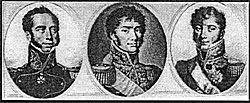 At right: On left, Baron Gaspard Gourgaud. Aide de camp to the exiled Emperor. Napoleon forbade him to duel with his enemy de Montholon. Center, Count Henri Gratien Bertrand. Grand Marshal of the Palace. He went in exile as into battles, with total devotion Napoleon. Right, Count Charles Tristan de Montholon. Bourbonist major-general and Napoleon's maréchal de camp. The ending of the St. Helena story was known to him long before it happened.
At right: On left, Baron Gaspard Gourgaud. Aide de camp to the exiled Emperor. Napoleon forbade him to duel with his enemy de Montholon. Center, Count Henri Gratien Bertrand. Grand Marshal of the Palace. He went in exile as into battles, with total devotion Napoleon. Right, Count Charles Tristan de Montholon. Bourbonist major-general and Napoleon's maréchal de camp. The ending of the St. Helena story was known to him long before it happened.
In 1974, when I met Sten Forshufvud, we decided to work together to prove once and for all that Napoleon was indeed poisoned. For this purpose we constructed two time charts. On the first chart, we listed the symptoms as reported by the eyewitnesses on specific dates leading up to his death.
The eight eyewitnesses reported independently from each other, in books and diaries, the various symptoms that Napoleon suffered from. We used these symptoms as the basis of this chart, which covered a period of several months prior to his death.
These eyewitnesses were all companions of the exile and they are the Marquis Las Cases, Baron Gourgaud, Dr. Barry O'Meara, Dr. Francesco Antommarchi, Grand Marshall Bertrand, Louis Marchand, the Emperor's loyal valet of ten years; and two English doctors called Henry and Stokoe. These eight people had regular access to Napoleon and observed him on a daily basis, and they all kept independent diaries of their lives on St. Helena.
On the second time chart, we recorded the arsenic levels obtained from the testing on the sectional analysis of Napoleon's hair at Harwell Nuclear Research Laboratory. We used a sample of Napoleon's hair that was shaved at the scalp on May 6, 1821, the day after he died.
The two charts matched. On the days when Napoleon was reported to be suffering from symptoms identical to those of arsenical intoxication, the Harwell reports showed high levels of arsenic in the hair. Both Harwell and the FBI confirm these findings as symptoms of arsenical intoxication.
These tests confirm, through modern scientific methods, that the symptoms recorded by the eyewitnesses over 178 years ago were indeed symptoms of arsenical intoxication. No suppositions here; JUST FACTS.
Since it has been established that hair grows at approximately one inch every two months, if it is shaved at the scalp and the date is known, then tests for arsenic in the hair can determine almost to the day when arsenic was ingested.
It is important to realize that in 1821, as in the 1990s, it is rare that during an autopsy the doctor would suspect arsenic poisoning unless he was told in advance.
Sten Forshufvud met Professor Henri Griffon, Chief of Toxicology of the Paris police, who has had a lot of experience with cases of arsenic poisoning, and he asked him if he could explain why so many doctors, then and even now, could overlook arsenical intoxication as a possible cause of Napoleon's death. Professor Griffon replied that he never found, in any case of murder by arsenic, a doctor who had correctly diagnosed arsenical intoxication as the cause of death.
Therefore, it must be conceded that none of Napoleon's doctors can fairly be blamed for not having understood his illness. They were simply not trained to understand the symptoms of arsenical poisoning. Arsenic trioxide is tasteless and odourless --- a first-rate poison.
Arsenic poisoning has many guises, and the symptoms are very misleading. That is exactly what led Dr. O'Meara to believe that Napoleon was suffering from dysentery, scurvy, gout, ulcers, and other ailments. If a doctor took two or three of the arsenic symptoms separately, he could be misled to the identity of the illness. To diagnose arsenic poisoning, a doctor must identify all of the victim's symptoms together and compare them specifically with those of arsenical intoxication. Unless the doctor is informed or suspects in advance, there would be no reason to suspect arsenic, because the symptoms themselves taken individually, resemble those of so many other diseases.
Let me give you an example of the symptoms described by one of the eyewitnesses: Doctor Francesco Antommarchi was Napoleon's personal physician. In his diary entry dated February 26, 1821 he writes: "The Emperor had a sudden relapse, dry cough, vomiting, sensation of heat in the intestines, generally disturbed, discomfort, burning feeling that is almost unbearable, accompanied by burning thirst."
On February 27, 1821, he writes: "The Emperor is worse yet than yesterday. The cough has become more violent and the painful nausea did not stop till 7:00 this morning."
This eyewitness report was confirmed by the nuclear analysis of Napoleon's hair which showed another peak of arsenic content at this particular period, thereby proving that he was ingesting poisons.
 Longwood House (Watercolor painting of Louis Marchand). This watercolor painting was offered to the Emperor on the 1st of January 1820. On the right we notice Vignali and Buonavita walking in the garden where 2 Chinese men worked. On the left hand side is Mrs. Bertrand with her children. Napoleon is standing at the entrance of the veranda.
Longwood House (Watercolor painting of Louis Marchand). This watercolor painting was offered to the Emperor on the 1st of January 1820. On the right we notice Vignali and Buonavita walking in the garden where 2 Chinese men worked. On the left hand side is Mrs. Bertrand with her children. Napoleon is standing at the entrance of the veranda.
It's important to be aware that Napoleon did not die from arsenic poisoning, but instead was poisoned to death in two phases, by a method used by professional poisoners of the period. The "classical method" of killing somebody without making it appear to be a criminal act consisted of a "cosmetic phase" followed by a "lethal phase".
The "cosmetic phase" of Napoleon's poisoning started in mid-1816, and this was done through the use of arsenical intoxication. There is, however, evidence that the intoxication by arsenic was used during the Waterloo campaign, several months before Napoleon's exile. Arsenic is an essentially colourless, odourless and tasteless substance which is easily administered in food or wine, and the total quantity needed to carry out a planned assassination would have fitted into a small envelope.
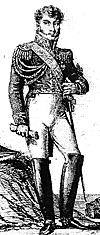 At right: Count Charles Tristan de Montholon following the instructions of King Louis XVIII and the Count of Artois, succeeded in poisoning Napoleon during his exile on the Island of St. Helena.
At right: Count Charles Tristan de Montholon following the instructions of King Louis XVIII and the Count of Artois, succeeded in poisoning Napoleon during his exile on the Island of St. Helena.
Napoleon was poisoned slowly and chronically with arsenic in order to break down his health and make it appear that he was deteriorating in a normal and natural way from disease. To kill him outright would have meant a revolution in France, because the French army was still loyal to Napoleon, as were the majority of the French people.
To be successful in this phase of the process, the assassin would have to have access to the food or wine that the Emperor was to consume, but at the same time he would have to ensure that he did not poison anyone else. The food eaten at Longwood House was shared by all of those living there, but Napoleon had his own wine supply, which was the vin de Constance, a wine brought in from Capetown especially for him. This wine was drunk only by the Emperor; the others used whatever wine was available at the time.
In their diaries and notes, the eyewitnesses record very carefully more than 30 symptoms that indicate chronic arsenical intoxication. When you list these symptoms and compare them to the arsenical intoxication symptoms described in any modern book on toxicology, you will find that they are identical.
TO IGNORE WHAT THESE EYEWITNESSES TELL US IS TO IGNORE HISTORY.
If Napoleon was not being fed arsenic during the cosmetic phase of the poisoning, then why did these eight eyewitnesses, independently of each other, record typical arsenical intoxication symptoms? If Napoleon died of cancer, then why did he die fat and not show any symptoms of cancer? It's simply because he didn't die of cancer. This is clearly obvious.
THE LETHAL PHASE OF THE ASSASSINATION STARTED IN MARCH 1821 and, had it not been for modern forensic medicine and our dedicated investigation, it would have been a perfect crime. This phase was done through the introduction of toxic medications such as tartar emetic, followed by orgeat and calomel.
Dr. Antommarchi writes that on March 22, 1821, Napoleon was given a lemonade drink with an emetic. In the following days, Napoleon was given additional emetic drinks. Tartar emetic is antimony potassium tartrate; it is highly toxic and induces vomiting. Its symptoms resemble those of arsenic, and it is no longer used because of its high toxicity.
Given the limitations of medical knowledge at the time, it was quite common for doctors to prescribe a tartar emetic in the hope that, by vomiting, the body would rid itself of the ills for which the doctors had no other treatment. Antimony potassium tartrate corrodes the mucous lining of the stomach. This eventually inhibits the normal vomiting reflex by which the stomach protects itself, and the patient becomes unable to expel poisons.
This is exactly what the poisoner wanted, and what happened, because giving Napoleon the tartar emetic over a period of time ensured that mercury cyanide would not be vomited and would remain in his body in order to complete the poisoning method of the period. The mercury cyanide resulted from the combination of orgeat and calomel, and now I'll explain how it worked to kill the Emperor.
On April 22, a new drink appeared for the first time which was served to Napoleon. It was orgeat. This is an orange-flavoured drink which includes the oil of bitter almonds. It was served to Napoleon to help quench his thirst. Thirst, incidentally, is one of the symptoms of chronic arsenical intoxication.
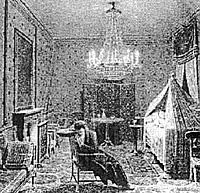 At right: The last agonizing moments of Napoleon's death. Loyal Louis Marchand, his companion in exile, is seen expressing his overwhelming grief.
At right: The last agonizing moments of Napoleon's death. Loyal Louis Marchand, his companion in exile, is seen expressing his overwhelming grief.
In the Grand Marshall Bertrand's diaries, page 165, he states very clearly that on April 25, 1821, a case of bitter almonds arrived at Longwood House. Bitter almonds are the ingredient in orgeat that contains hydro-cyanic acid, or Prussic acid.
Before that date, there were no bitter almonds available on the island. Apparently the poisoner was starting to be concerned that bitter almonds would not arrive on time, because the Grand Marshall Bertrand states clearly in his diary on page 166 that someone (although he does not mention his name) asked his four-year-old son, Arthur, to go out and collect some peach stones and leave them in the pantry.
Peach stones can serve the same purpose as bitter almonds, since they both contain hydro-cyanic acid. You will soon learn how this helped kill Napoleon without any tell-tale signs of criminal activity.
It is interesting to note that during the Holocaust, in the Second World War, the Concentration Camp commanders were ordered to use hydrocyanic acid (prussic acid) to murder the countless millions of inmates. The Concentration Camp guards that were obligated to remove the dead bodies, reported that they "smelled a type of peach aroma in the air and sometimes the smell of almonds".
The ingredient in orgeat is "bitter almonds" and if they are unavailable, the stones from peaches would act in the same manner. Therefore, when the guards detected that they smelled almonds or peaches, as they removed the dead bodies, they were "right on the truth".
For references, see "Death Dealer's", page 155, under the heading of "Gassings". This book was written by the "commandant" of the Auschwitz Concentration Camp., Mr. Rudolph Hoss. After the war, Hoss was convicted and hung for his crimes.
In a new book entitled "Clinical Toxicology" it states on page 105: "Oil of Bitter Almonds. The oil is rapidly poisonous when ingested and death occurs promptly when an adult drinks 7.5cc." Although Napoleon was not given such a large dose, the amount he got is considered a chronic amount.
The Grand Marshall tells us in his book that a few days before Napoleon's death, on the night of May 2-3, 1821, and all the following day, he was extremely thirsty and drank a lot of orgeat. Remember, thirst is a symptom of arsenical intoxication.
Antommarchi's diary reports that he was concerned about Napoleon being heavily constipated. Constipation is also a symptom of chronic arsenical intoxication. The favourite medication of the day for this purpose was called calomel. In a book entitled "Clinical Toxicology of Commercial products," on page 91, it states that calomel contains mercury chloride.
Now, this is important.
Louis Marchand, who was Napoleon's first valet, in his diary on pages 323 and 324 writes that at 5:30 p.m. on May 3, 1821, without his knowledge or approval, Napoleon was given 10 grains of calomel, a very heroic dose indeed. This was up to 40 times the normal amount, because the normal dose of calomel for constipation in those days was one quarter of one grain.
The Grand Marshall Bertrand also confirms this in his diary on page 192. This was the irrevocable moment of the final lethal phase which was directly responsible for Napoleon's death.
Calomel contains mercury chloride, and orgeat with bitter almonds contains hydro-cyanic acid, or prussic acid. Together they combine in the stomach to form mercury cyanide which would then be expelled from a healthy stomach by vomiting. But Napoleon had been given several drinks containing a large quantity of tartar emetic and this would have inhibited the vomiting reflex. Consequently, the highly toxic mercury cyanide was retained.
In the Sir Hudson Lowe papers, volume 20, 214 on pages 204 and 206, are two letters written to Sir Hudson Lowe by Dr. Robert Gooch. In these letters he criticizes Dr. Antommarchi's book from a medical point of view. Dr. Gooch was a very well-known medical officer of the time, and wanted to write a review of Antommarchi's book, but this never happened. Dr. Gooch told Sir Hudson Lowe clearly that "the agency of calomel freely administered was much more responsible for the death of Napoleon than hepatitis, the climate or cancer."
Dr. Gooch, in suspecting that calomel had something to do with Napoleon's death, came closer to the truth than any other medical officer from 1821 until this day.
Now what happens? The Grand Marshall Bertrand, on page 192, writes: "Shortly afterwards, he fell unconscious. He was completely immobilized by a total paralysis of the voluntary muscles. He could not even swallow."
It is well documented that mercury cyanide paralyzes the voluntary motor functions. Forty-eight hours after taking the calomel, and never again regaining consciousness, Napoleon died.
What does mercury cyanide do to the stomach? It corrodes the stomach walls, and creates an annular swelling of the pylorus muscle. The Larousse Medical Illustrated Dictionary explains, on pages 741-742, the very toxic effects of orgeat and calomel, and warns against combining them as a treatment. The autopsy performed by Antommarchi and observed by many others, including the English doctors, showed that the stomach lining had been heavily corroded and there was a significant annular swelling of the pylorus muscle. However, not suspecting poisoning, the doctors, except for Dr. Antommarchi, who was the only pathologist present, concluded that Napoleon had died of "a condition leading to cancer."
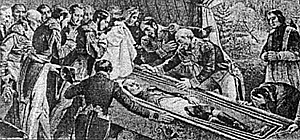 At right: Nineteen years after Napoleon's death and entombment at St. Helena, his casket was opened to identify Napoleon before returning the body to France as the Emperor desired. Former attendants present, aged by nearly two decades, were astonished to see that the emperor's unembalmed body was almost perfectly preserved. Arsenic has checked the processes of decay in the triply enclosed and sealed coffin.
At right: Nineteen years after Napoleon's death and entombment at St. Helena, his casket was opened to identify Napoleon before returning the body to France as the Emperor desired. Former attendants present, aged by nearly two decades, were astonished to see that the emperor's unembalmed body was almost perfectly preserved. Arsenic has checked the processes of decay in the triply enclosed and sealed coffin.
In fact, he died of cyanide poisoning, following chronic arsenic intoxication. You and I know that people do not die from a condition leading to cancer - one dies of cancer.
It is interesting to note that Doctor Henry, after the autopsy, wrote a report for Sir Hudson Lowe and he noted how effeminate Napoleon appeared, because he had no body hair. He should have realized that a loss of body hair is a symptom of chronic arsenical intoxication.
Dr. F. Antommarchi, who attended the Emperor during the last twenty months of his illness, persisted in maintaining, after his return from St. Helena, that he died of chronic hepatitis contracted in the unhealthy climate of the island. Larrey, the surgeon-in-chief of the Imperial guard -- the "most upright man I have ever known" as Napoleon himself said -- remarked, after reading the post mortem report, that it indicated clearly that the Emperor had died of an acute liver affection. Larrey recognized that the stomach lesions were secondary and certainly not cancerous.
The Marquis Henri de Montchenu was appointed by Louis XVIII to represent France at St. Helena during the exile. Montchenu reported the day after Napoleon's death, saying - and I quote - "...of the five doctors present at the autopsy, not one knows the exact cause of his death."
In the book "Poisoning Drug Overdose," on page 744, it states that "Cyanide is one of the most rapidly acting of all poisons, and in the form of hydro-cyanic acid and its sodium and potassium salts, it is one of the most deadly." Oil of bitter almonds in the orgeat contains hydro-cyanic acid.
Was there a poisoner on the island? You bet there was. Here are some of the facts. No suppositions, just facts. On February 24, 1818, Cipriani, the major domo, who was really Napoleon's secret agent, fell ill without warning, though he was always in perfect health. He was seized with violent pains in the stomach and with very cold chills.
They placed him in hot baths. Chills and stomach pains are signs of acute arsenical intoxication.
Two days later, at 4:00 p.m., he died. Cipriani was buried immediately, but somebody must have secretly exhumed his body, for it disappeared. Why? Somebody was concerned that an autopsy would show up the poisoning, because it is easy to detect acute arsenical intoxication. His death proves that there was a poisoner on the island living at Longwood House.
In fact, William Balcombe, who allowed Napoleon to stay at his tea room called "The Briars" while Longwood House was being repaired and enlarged, became a friend to Napoleon, and he always believed that Cipriani was poisoned, because he asked that the tomb be opened and an autopsy be performed, but the body disappeared before this could be done.
It is interesting to note that the Grand Marshall Bertrand, in a letter to Cardinal Fesch, stated that a few days after Cipriani's death, a maid in Montholon's employment and a young child died with the same symptoms. Did they eat or drink by accident something that Montholon had prepared for Cipriani?
We'll never know, but it is a strange coincidence indeed.
Now, you must be asking the key question - since Napoleon was poisoned, then who did it?
We must consider these facts in order to come to a conclusion: whoever poisoned Napoleon had to be on the island and living in Longwood House, the prison home of Napoleon, during the entire exile of over five years, because Napoleon was suffering intermittently from the same symptoms during the entire period.
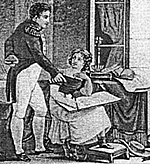 At right: Napoleon and Betsy Balcombe. During his first month of his stay at St. Helena, Napoleon was lodged at the Briars, a small teahouse which was part of the Balcombe Estate. Very quickly, Napoleon became friends with the 14 year old Betsy.
At right: Napoleon and Betsy Balcombe. During his first month of his stay at St. Helena, Napoleon was lodged at the Briars, a small teahouse which was part of the Balcombe Estate. Very quickly, Napoleon became friends with the 14 year old Betsy.
The most important factor to consider is that whoever was administering the arsenic was doing so from the beginning of the exile, and continued until the second, or "lethal" phase in 1821.
This immediately eliminates all the people who left St. Helena before Napoleon died, and also eliminates those who arrived during the exile. Therefore it leaves just Louis Marchand, the valet, the Grand Marshall Bertrand, and the Comte de Montholon. The person responsible for the poisoning would have to be in regular contact with Napoleon, and therefore had to live in Longwood House.
This immediately eliminates the Grand Marshall Bertrand, who lived some distance away, since his English wife wanted more privacy and did not like to be in close proximity to the other companions of the exile. Bertrand attended the Emperor as and when required by him.
There were only two people who had this very close contact with Napoleon daily, and who were able to enter his room whenever it was necessary, and who had meals with him on a regular basis.
These were the Comte de Montholon and Louis Marchand. Louis Marchand is recognised by all historians, and the companions of the time, as a loyal, devoted valet who served Napoleon like a son. He had absolutely no possible motive to harm Napoleon.
The Comte de Montholon, on the other hand, had no reason to admire nor wish to serve the Emperor on St. Helena, yet he volunteered his services to do so. Consider that Napoleon was only 46 years of age at the time and in good health, and he could have lived at least another 20 years. This could have meant that Montholon would have had to spend a good part of his life serving him.
Unless he was an agent of the Bourbons, and knew in advance that he would need to spend only a few years on the island because of his assignment to poison Napoleon, there would be no logical reason for him to do this.
One of the reasons that Montholon was upset with Napoleon, is that he had ordered Montholon's discharge from his post as the French envoy to Wurzburg, after he married the twice-divorced Albine Roger against Napoleon's wishes.
The Comte de Montholon was a very strong royalist. Consider the following facts:
- 1. His stepfather, the Comte de Simonville, was a close friend of Louis XVIII and the Comte d'Artois.
2. Comte Charles-Louis de Simonville was known as a very crafty individual who continued to serve successive French regimes from Louis XIV to Louis-Philippe. This was indeed a great accomplishment in those days. The Comte de Simonville was known to be an agent of the Arch-Bourbon, the Comte d'Artois, brother to King Louis XVIII.
3. For services rendered to the House of Bourbon, the King made Simonville a peer in the new French House of Lords. Therefore he occupied one of the highest offices of state.
Comte de Montholon was raised bearing the name Montholon-Simonville. However, when he left to go to St. Helena, he very cleverly dropped the Simonville part of his name and went as simply Comte de Montholon. Montholon was also known as a playboy, he was always in debt, and enjoyed the fast life.
Why would a man with that background want to spend at least 20 years of his life serving Napoleon on St. Helena unless he had specific orders to prevent Napoleon from returning to France by poisoning him?
Consider that the Comte de Montholon was the sommelier, and had exclusive access to Napoleon's wine. It was through the wine that Napoleon was poisoned. Arsenic powder is neutral - it has no taste - and could be put into wine whenever Montholon wanted to.
In fact, Baron Gourgaud, in his memoirs, records that he warned Napoleon that he might be poisoned through the wine. However, Napoleon did not take this warning seriously.
Consider also that Montholon was a major beneficiary of Napoleon's will, and was appointed one of the three executors. Montholon was alone with Napoleon when he prepared his last will and added codicils.
Montholon actually was left over 2,200,000 francs, a huge amount of money in those days, and yet he was bankrupt and had to flee to Belgium to escape his creditors in 1829.
During his stay at the defence establishment in 1814, while Napoleon was at the Elba in exile, Montholon had appropriated to himself some military funds amounting to 6,000 francs. Yet he was never punished for this crime, thanks to the intervention of the Comte d'Artois who later became Charles X, King of France.
Consider that it was Louis XVIII who appointed the Comte de Montholon a General in the French army during the period of Napoleon's exile on the Elba. All historians, even those who don't agree that Napoleon was poisoned, agree that Montholon was a very scheming and unscrupulous man who lied on a regular basis.
My colleague, Sten Forshufvud, and I believe that he was an agent of the Bourbons, and the facts point to this. As such, he would have pursued the King's wishes against the man who was categorized at the time as an outlaw and an enemy of peace in Europe.
Consider this: Each of the companions who shared the exile with Napoleon wrote a book or kept memoirs. They all reported more or less the same symptoms that Napoleon suffered from, except the Comte de Montholon.
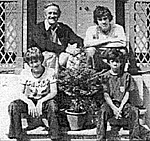 At right: Ben Weider and his sons in 1975, seated on the steps of the entrance of Longwood House in St. Helena. Louis – on the top right, Eric – on the bottom left and Mark – on the bottom right. Note the small tree that they planted near the Tomb. Today it must be a large tree.
At right: Ben Weider and his sons in 1975, seated on the steps of the entrance of Longwood House in St. Helena. Louis – on the top right, Eric – on the bottom left and Mark – on the bottom right. Note the small tree that they planted near the Tomb. Today it must be a large tree.
One example is that Montholon reported that Napoleon was emaciated when he died, yet all the others, including the British doctors who were present at the post mortem, said that Napoleon was excessively fat.
In order to confirm the cancer report, he had to claim that Napoleon died in an emaciated condition. Gaining weight is a symptom of chronic arsenical intoxication. Louis Marchand was the only companion of the exile still alive when Montholon's book was published in 1848. emaciated He said that Montholon was either a liar or his memory had failed him. Substantial parts of Montholon's memoirs were totally different from those of his companions.
It is our view, Sten and I, that the Comte de Montholon was sent to Ste. Helena by the Comte d'Artois (later to become Charles X, King of France) to ensure that Napoleon would never return to France as he did following his first exile to the Elba.
Ladies and Gentlemen, we have found the method used in the assassination of Napoleon, and by looking at the opportunity and motive, we have found the murderer.
The case is very clear. Napoleon was murdered by the Comte de Montholon, using chronic arsenical intoxication followed by acute cyanide poisoning. As an agent of the Bourbons, he succeeded with his mission.
Montholon had the opportunity, competence and credible motive to achieve secretly the removal of any likelihood that Napoleon might return to claim the throne from Louis XVIII.
Ladies and Gentlemen, I ask you - were the eight eyewitnesses hallucinating when they recorded independently of each other more than 30 symptoms of arsenical intoxication?
Not to recognize the symptoms they described is to ignore history and suggests a terrible blind spot.
Was the Harwell Nuclear Research Laboratory, one of the most respected laboratories of its kind in the world, which actually helped produce the atomic bomb for England, wrong in their analysis of Napoleon's hair which showed high dosages of arsenic up to 51.2 ppm? Impossible.
All historians agree that Napoleon died fat, and was not in the wasted condition that cancer would produce, especially after five years without treatment. Getting fat is another symptom of arsenical intoxication. Why? Because chronic arsenic poisoning causes obesity.
The epilogue to this is that after 19 years, when Napoleon's body was exhumed to be returned to France, it was in an excellent state of preservation. Why? Because it is consistent with arsenic poisoning, because although arsenic could kill, it also preserves tissues.
Professor Guériot , Président of "l'Académie de Médecine de Paris (1996) said that "the state of preservation of Napoleon's body is a sign of arsenic".
Finally, I'd like to read the last sentence of a two-column book review published by Newsweek magazine in its book section when my first book, entitled "The Murder of Napoleon" was published:
 At right: St. Helena by J. Clark and J. Hamble, c. 1806
At right: St. Helena by J. Clark and J. Hamble, c. 1806
- THE EFFECT IS HISTORY AT ITS MOST ELECTRIFYING. IT WILL SURELY DRAW THE WRATH OF NAPOLEONIC SCHOLARS. I CANNOT BE SURE THAT FORSHUFVUD AND WEIDER ARE RIGHT, BUT TO PROVE THEM WRONG, THEIR OPPONENTS WILL HAVE TO PRODUCE AN IMPRESSIVE HAT AND HOPE THERE IS A RABBIT IN IT."
Our research now removes the unfortunate distortion of history and we have now established the truth, which is that Napoleon died from poisoning rather that cancer of the stomach.
I would like to bring to your attention that my new book, entitled "The Assassination at St. Helena Revisited," with all the details of the poisoning of Napoleon, has been published by John Wiley and Sons of New York, and is available in bookstores
More Assassination of Napoleon
Appendix A: Not Cancer
Letter 1: FBI Lab Test Results
Letter 2: Scotland Yard Murder Investigation
Letter 3: US Chairman Joint Chiefs of Staff
Letter 4: Warner Brothers Movie Deal
Back to War Lore: The List
Back to Master Magazine List
© Copyright 1999 by Dr. Ben Weider.
This article appears in MagWeb (Magazine Web) on the Internet World Wide Web.
Other military history articles and gaming articles are available at http://www.magweb.com